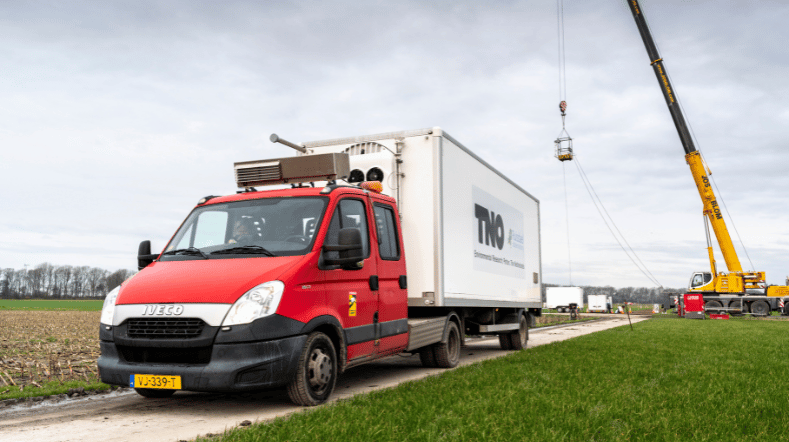
TNO staff get to grips with the nitrogen crisis with the Brains4nitrogen programme
Following the success of the Brains4corona programme, in which TNO focused on tackling the coronavirus in 2020, the organisation is now planning to launch more of these 'Brains4x' challenges. In the first of them – Brains4nitrogen – TNO is looking to get to grips with a crisis that has been occupying society for some time: the nitrogen crisis. 'We have plenty of knowledge available. Brains4nitrogen helps us to put that knowledge to immediate use, usually with knowledge partners and stakeholders,' explains Jaap Lombaers, Director of Knowledge Management & Partnerships at TNO.
The nitrogen crisis is a complex issue affecting housing, agriculture and many other sectors. Nitrogen emissions harm our nature areas and biodiversity, and the measures to reduce them are delaying construction projects and causing emission permits to be withheld, with all the consequences that entails. This crisis was chosen for its serious societal impact as the second theme in the planned Brains4x series, and all TNO staff were invited to put forward ideas. 'This programme is helping us to produce concrete solutions based on TNO's existing knowledge,' says Lombaers.
For Brains4nitrogen, more than twenty TNO teams have come up with ideas to tackle the crisis. Lombaers, who was also involved with Brains4corona, is pleased to see the series continuing. 'After successfully completing the programme, it struck us that we had discovered an extra formula that TNO could put to good use in society in the short term. It is great to see that all TNO colleagues were given the opportunity to come up with solutions.' The new approach certainly seems to work well at TNO. Lombaers: 'Everyone is bursting with enthusiasm. This programme is exactly what I like most about working at TNO. Being able to come up with solutions so quickly gives me a lot of job satisfaction.'
Brains4nitrogen: four different projects
In the end, four projects were selected to develop their proposed solution under Brains4nitrogen. The projects focus on various sectors (from construction to agriculture), and each has its own unique character. Programme leader Elodie Jegu: 'Some projects focus on technology that can be used to reduce emissions directly, while others contribute indirectly, for example by developing improved analysis methods that culminate in better-informed policies. Both types of solution are important, and it also helps that they complement each other.'
The projects certainly have something in common: the solutions the teams are working on can all be put straight to use in society. Jegu: 'The great thing about the project teams is that they challenged themselves to come up with solutions in the short term. They did this by making optimum use of existing TNO technology and knowledge. They also maintained close contact with the private sector and policymakers to gain a clear understanding of users' needs.'
The projects
Construction Equipment Emission Measurement Solutions
Construction Equipment Emission Measurement Solutions deals with nitrogen emissions from construction equipment. Over the past five years, TNO has developed its own measurement and monitoring tools for other applications. The project makes these tools readily available to the construction industry, focusing on construction equipment. That gives construction companies, permit issuers and government agencies a clearer insight into the nitrogen emissions released when these machines are operated. That forms a solid basis for making decisions about deployment, maintenance planning, and mechanical adjustments to reduce nitrogen emissions.
N2-ABLE
N2-ABLE focuses on the agricultural sector, specifically on thermochemical manure processing. Manure from cattle and pig farming is one of the primary sources of ammonia emissions in the Netherlands. The N2-ABLE system can be used on site at the farms whose nitrogen emissions are the most critical in order to limit the nitrogen (NOx) emissions. Manure is processed in the system with a technology previously developed by TNO for waste sludge processing, creating a solid and liquid fraction. The solid part can be used as fuel for power plants, with minimal nitrogen emissions due to the NOx stripping measures they already have in place. Harmful nitrogen compounds in the liquid part are converted into harmless nitrogen, resulting in usable fertilisers.
Emission-free construction
Emission-free construction focuses on reducing nitrogen and other emissions such as CO2 and particulates in the construction sector. The software developed for this purpose helps construction companies and their clients to make choices: for each construction project, the project team identifies which combinations of measures the companies can take to reduce nitrogen emissions and which of them will lead to the greatest reduction. The tool was developed by first analysing one construction project in detail: the 'Singelgrachtgarage' building project in the centre of Amsterdam. The software includes a wide range of measures, such as smart and clean construction logistics and the use of emission-free construction equipment.
Eddy-covariance measurements
Eddy-covariance measurements involves developing a method to improve the measurement of aerial nitrogen deposition. An important question in the nitrogen crisis is that of how much reactive nitrogen (in the form of ammonia) ends up in the Natura 2000 areas (Europe's protected and most vulnerable nature areas). Even slightly exceeding the permissible deposition levels severely hampers economic activities in these areas, making sufficiently accurate measurements of great importance. Decisions are still based on measurement technology from the eighties and nineties. The 'Eddy-covariance' technology is the standard for other measurements (greenhouse gas measurements). In this project, TNO, together with RIVM, has shown how this technology can be used to measure ammonia deposition.
Every bit helps
The nitrogen crisis cannot be solved within a few years with a single one-size-fits-all solution. Even the Brains4nitrogen programme can only make a modest contribution, Jegu admits. 'But all initiatives that can contribute are welcome and much needed. The nitrogen crisis is especially intractable and every little bit counts. The projects also serve as an inspiration for other teams and projects and sometimes help them speed up progress.' Lombaers agrees. 'In the Netherlands, many parties are already working on the nitrogen crisis. Brains4nitrogen is modest in size compared to the total investments and efforts in this field. But by smartly reusing knowledge already developed at TNO, we can make a worthwhile contribution.'
Get inspired
Mapping out biodiversity thanks to particulate matter filters


Predicting farm emissions from mobile measurements


Nitrogen


